6 Reasons Why Traveling To India Is A Life-Changing Experience
6 Reasons Why Traveling To India Is A Life-Changing Experience
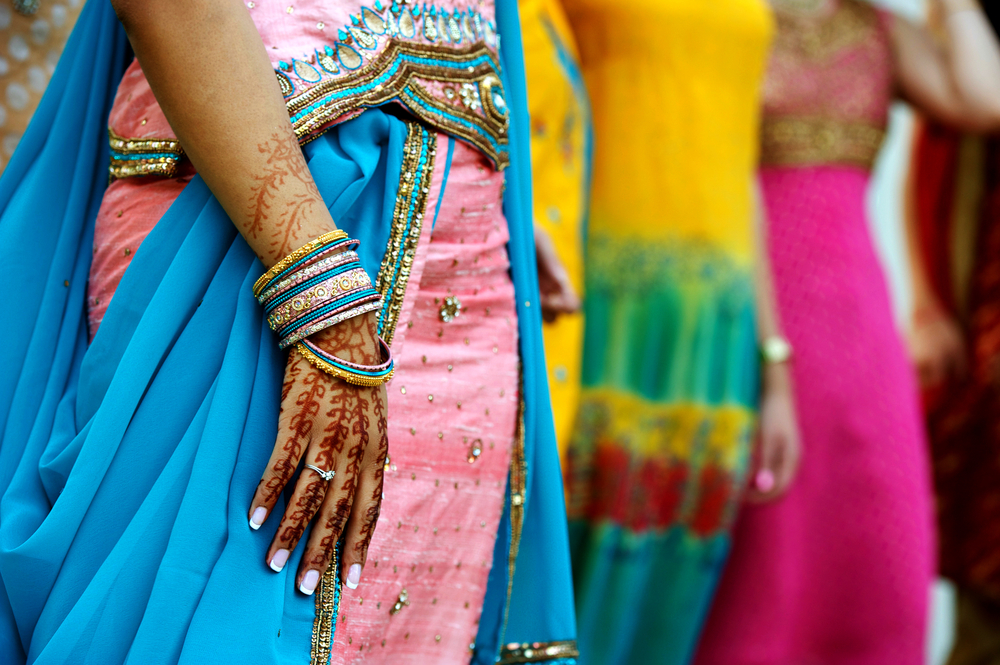
Shutterstock / infinity21
Many things have been said about India in the last couple of years; from the adventurous tales in this exotic land of food, fragrances and sounds, to the horrific stories of sexual harassment and violent rapes.
So what is India all about? Is it a country where women can feel safe? Is it a country filled with incredible culture and delicious food where every day is filled with a new adventure?
I’ve spent half a year traveling the whole triangle of this subcontinent, met hundreds of people and had a mix of good and challenging experiences. One thing I can tell you as a fact: love it or hate it, India will never get boring!
1. Let The Diversity Of India Blow Your Mind
India is HUGE! I had no idea of how much of a challenge I had ahead of me when I embarked to India, to visit the four corners of this subcontinent for 6 months.
But you know what? It’s the dimensions of India, that makes this place special. From the overcrowded and overwhelming streets of Delhi or Mumbai, to the absolute wilderness and solitude of the northern regions bordering Nepal…. From the tropical Andaman beaches to the deserts of Rajastan, India will never stop to surprise you.
And the diversity doesn’t stop with the impressive landscapes, the culture, language and gastronomy changes from north to south, east to west. India offers a place for everyone, no matter what your favorite climate is.
2. Get Curried Away By The Indian Flavors
Trying new foods is probably my favorite activity while traveling around the world. I love eating where the locals eat and rarely go for tourist restaurants. And so did I when I went to India.
As a life long vegetarian, I have to admit I felt in heaven. When arriving to Delhi, and being totally ignorant on whatever the menu said, I didn’t even had to bother. I would just enter a vegetarian restaurant and point to the dish I wanted to try, having no idea what was coming out of this. And I always had a pleasant surprise. Indian food is, in my opinion the best in the world and balanced to bring your health into perfect balance. Have you ever wondered why they have little compartments with different curries in each one of them? Well, that’s because the ancient ayurvedic medicine teaches us to balance the six flavors into every meal: salty, sweet, bitter, sour, spicy and astringent.
3. Ancient Traditions, Gurus, And Charlatans
Every year hundreds of thousands of people flock to India in order to find themselves, whether through Yoga, meditation, to study Buddhism or Hinduism or simply to wander around searching for an answer to life.
If you are part of the bunch who loved India you might just find yourself there. On the other hand, if you’re part of the other half that hated it, you might get into crisis, and let me explain why: India can either offer the best teachers or the worse charlatans and fake gurus.
What I have observed over and over again, is that most yoga and meditation classes are either taught by westerners or charlatans, and both of them charge huge sums of money. Yes, I’ve searched for good teachers along the way and I struggled to find genuine ones. This is because Yoga is deeply associated with a stereotype, we westerners have of India. No, not every Indian is practicing yoga, in fact, yoga is basically dead within the Indian community.
So do your research before you buy your tickets if yoga is what you’re searching for. There are in fact a few very good and honest yoga teachers there, but you need to find them. Some of the famous ones can be found in Rishikesh, Mysore, Chennai.
Same thing goes for spiritual teachers and Ashrams, there are a few inspiring and amazing teachers who are genuine, but you’ll have to do your homework. I visited Amma’s Ashram in Kerala, the only female guru and I was positively surprised.
4. Money Can’t Buy Happiness
One of the things you will encounter while in India, to a higher or lesser degree depending on how you’re traveling and what your budget is like, is poverty.
I’ve seen so much poverty in India, it affected me deeply. I’ve seen people eating from piles of trash, children begging everywhere in the cities of Delhi and Mumbai. It’s right on your face and you can’t avoid it, but you know what?
Parallel to that poverty, I’ve seen a sense of community, contentment and peace I’ve never encountered in the west. India is the prove that money can buy a lot of things, but it can’t buy happiness. I’ve met Indians who had so little but were so happy and joyful, always with a big smile and a kind word to say.
I remember feeling jealous for the fact that people still live with their extended family near by, that even in the shanty towns, neighbors know each others names and interact with each other on a daily basis. I’ve noticed many Indians don’t experience loneliness and isolation like we do here in the west, where families are broken apart, divorces are the norm, where we don’t even know the name of our neighbor.
For this, I was amazed by the smiles I’ve seen in India, which taught me a huge lesson on human interaction, family and community.
5. Sexual Harassment
Yes, sexual harassment is a reality in India, but this is an unfortunate reality all over the world.
When I went to India I had no idea this could be a problem and as a matter of fact, I didn’t experience it in any way.
I never had an episode where I felt threatened or harassed. Maybe this is because I blend in easily and for most of the time people actually thought I was Indian, or maybe it was because sexual harassment might be more prevalent in some areas than others.
I’ve seen a couple of friends being touched and grabbed tough, and they were dressed modestly. Because harassment has nothing to do with how the female presents herself or what she wears, as it has to do with power and domination, having a travel buddy might be a good idea when traveling in this beautiful country.
I wouldn’t discourage any female from visiting India just because of the fear of harassment or rape. Instead, I would encourage females to visit certain areas only and avoid others.
I’ve had extremely positive experiences in Kerala, Goa, Andaman Islands, and the northern areas bordering with Nepal and Tibet. So if you’re a female, go for it, get a travel buddy and experience the best India has to offer.
6. Appreciating Our Home And Where We Come From
After 6 months traveling around in India, I went back home with a completely different understanding of the world around me. My life changed radically after that experience. All my ideas and perspectives were shaken tremendously.
When comparing the place I came from and India, I could value a lot of things I always took for granted back home. Things that were so mundane to me but that would change the world for so many Indians, like free healthcare, quality free education, a huge middle class, having a lot of freedom independently of my gender, etc…
Then I also realized how lonely and isolated we became in the west. Why did people start to push their family away? Why don’t we know our neighbors? Why do we have so much wealth and material things and have so much depressions, anxiety, panic attacks, dependency on drugs and alcohol, anorexia…?? Why did we fail so bad in the field of the affection and community? Why aren’t children playing around instead of watching TV and play playstation all day?
For all this and more traveling to India, can be, in my personal opinion, a wonderful experience, independently if you loved it or hated it. India will never leave you indifferent to whatever you will encounter and will revolutionize the way you see the world and yourself.
Is It Safe To Travel To India Right Now During COVID? – 2022
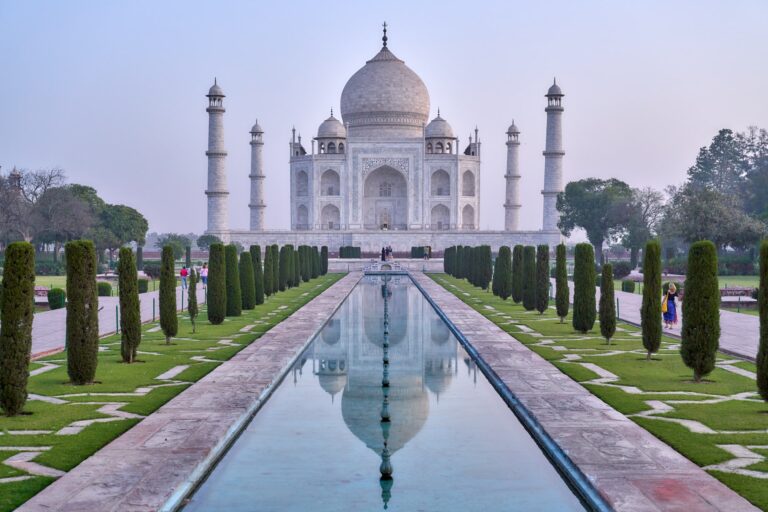
India is finally recovering from a couple of devastating months as the global center of the new coronavirus variant – the Delta variant. It brought the country’s health care system nearly to collapse.
Luckily, those times are over. The pandemic in India is now relatively under control. The CDC considers India a country with moderate COVID-19 transmission – orange. Yet, traveling to India for leisure is still banned.
The country closed its borders and halted most flights at the beginning of the pandemic. To date, only Indian nationals and people from certain countries on special visas can go.
Latest updates
October 13 – Active coronavirus cases lowest in 214 days
India is finally recovering from the spring spike in coronavirus cases. On October 13, the country reported 207,653 active cases, the lowest in 214 days, while daily infections have stood below 30,000 for the last 19 consecutive days.
As a result, the daily positivity rate now sits at 1,19 percent. On the other hand, the recovery rate is at 98,06 percent.
Also, over 96,43 million COVID-19 vaccines have been administered in India. That means at least 51,7% of the country’s population has received as least one dose of the vaccine.
Stats & current COVID-19 situation
Since the beginning of the coronavirus crisis, India has reported nearly 34 million COVID-19 cases. At least 450,963 of them have resulted in death.
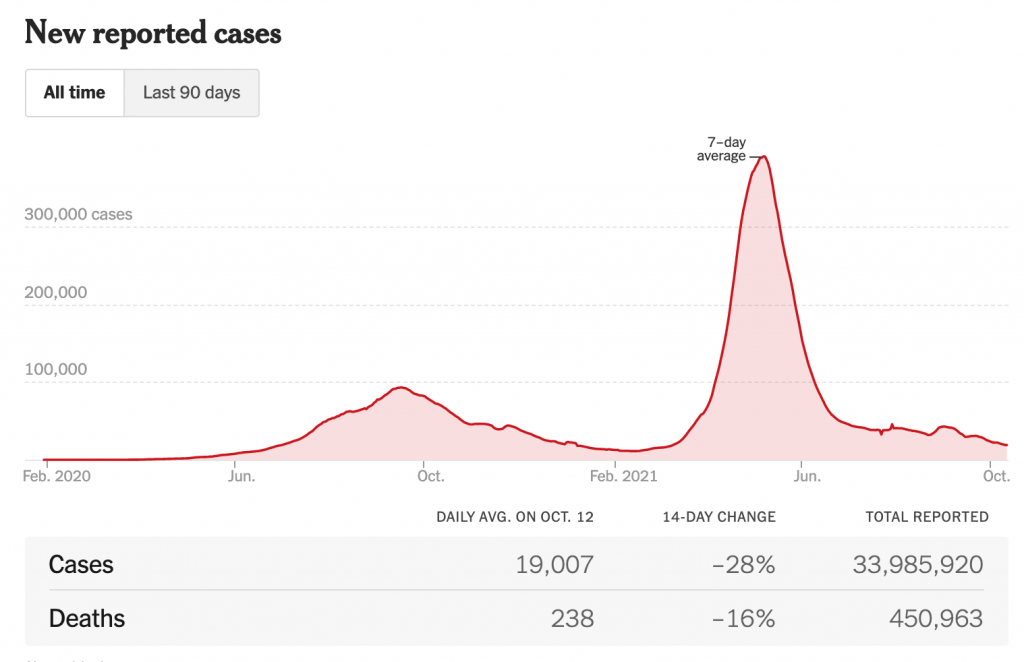
Source: The New York Times
At the moment, there are about 207,653 active cases and around 19,000 new infections daily.
Coronavirus hotpots in India
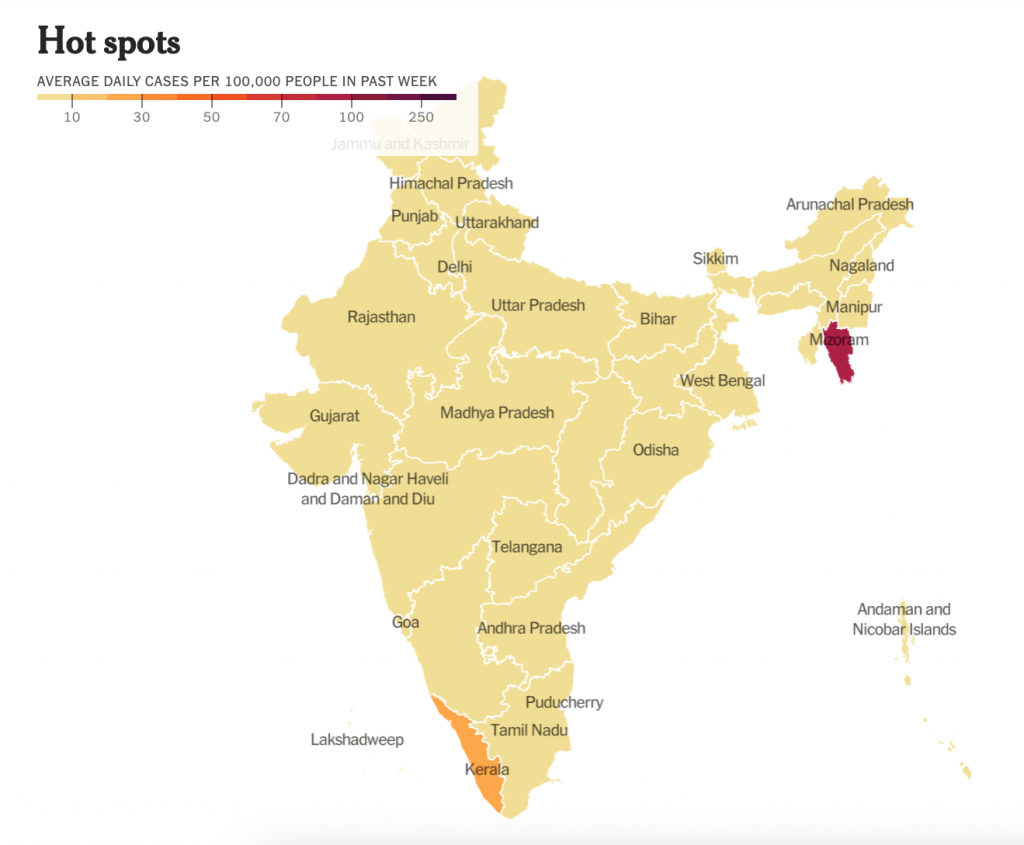
Source: The New York Times
Vaccination progress in India
India’s vaccination program started off with frontline healthcare workers, followed by vulnerable groups. Since May 1, all those aged 18 and above are also eligible to get their shot. Whereas 12+ children will be most likely able to get vaccinated this month.
As of October 13, 51,7% of the country’s adult population has received at least one dose of the COVID-19 vaccine. But only around a fifth of Indians have been vaccinated fully.
The vaccination rate is uneven across the state. The most populated state of Uttar Pradesh in northern India has managed to give at least one dose to only 40,9% of its citizens. On the other hand, a less populated state like Himachal Pradesh has given at least one shot to nearly every adult.
Who can travel to India
As mentioned above, India is still closed for tourism. Only returning Indians and Bhutanese and Nepalese nationals can enter the state. Also, those from certain countries who have other than tourist visas can go.
The United States, United Kingdom, and Canada have the strictest requirements. Only diplomats and those listed on the government memorandum can enter.
All incoming passengers must present a self-declaration form on the website of Air Suvidha and a negative COVID-19 test result no older than 72 hours. They also have to quarantine for 14 days.
Moreover, those arriving from the U.K. or the Middle East must provide their 14-day travel history and undergo further testing on arrival.
The latest information about India opening its borders can be found here.
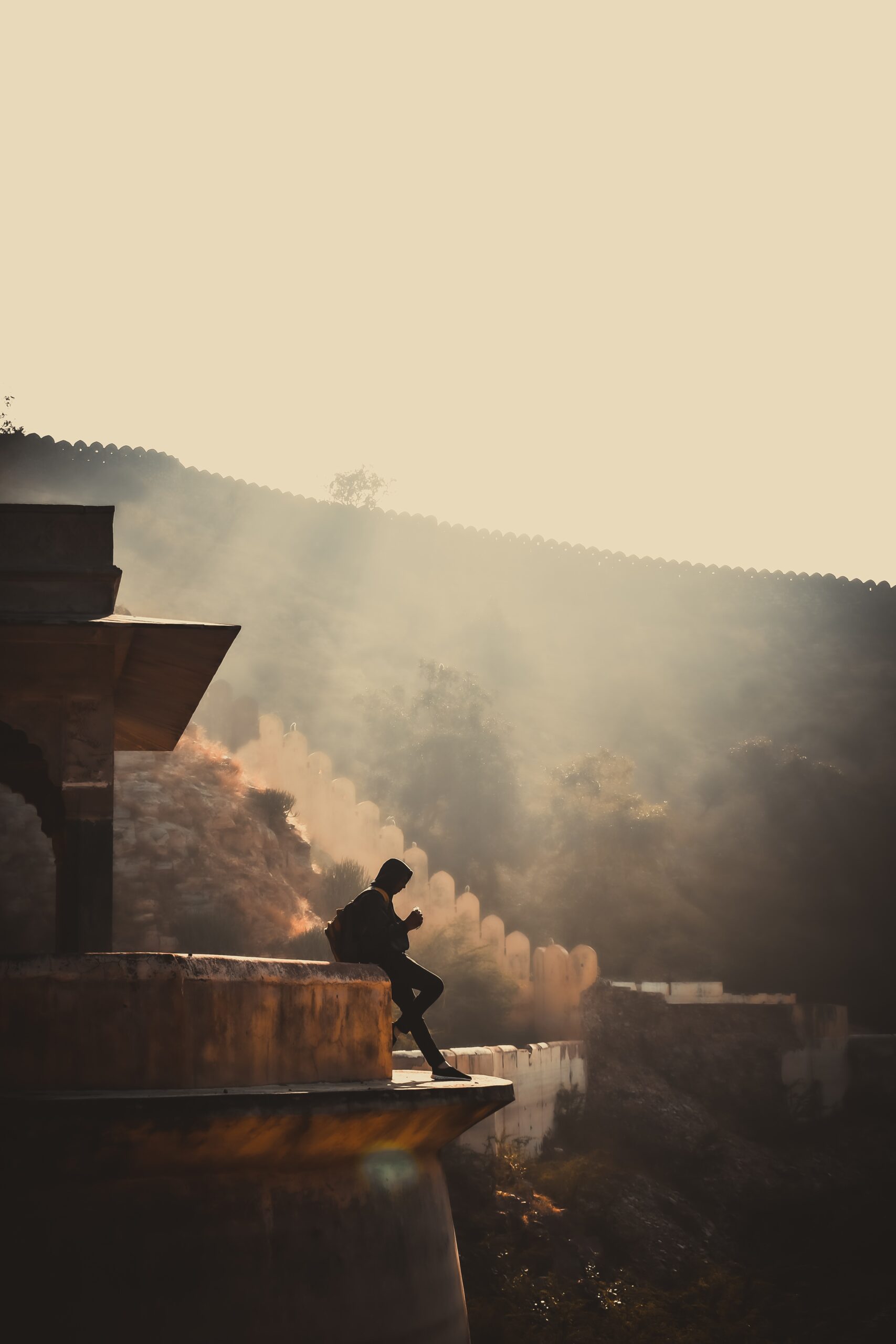
Why visit India?
We will have to wait for a little while more to visit India. However, there is definitely plenty of things to be looking forward to. From diverse landscapes and rich history to worldwide-known food and colorful culture, India is a country that should not be missed on any travelers’ bucket list.
Can I Travel To India?
Editorial Note: We earn a commission from partner links on Forbes Advisor. Commissions do not affect our editors’ opinions or evaluations.

As Covid-19 transmission concerns continue, countries have taken different measures to try to prevent the spread. Many countries have completely shut down their borders while others are sticking with tighter restrictions on travel for the time being. As the situation continues to evolve, the rules are short to change, possibly on short notice. Here’s what we know now about travel to India.
Looking for Travel Insurance?
Compare Quotes With Over 22 Travel Insurers
Can You Travel to India?
The answer: yes, and it’s getting easier to do so.
India reopened its borders to vaccinated international travelers, but due to new strains, there are several restrictions in hopes to slow the spread. U.S. citizens will need to adhere to various criteria, which we will cover later on.
Currently, India is classified as a Level 1—or low—travel risk by the Centers for Disease Control and Prevention (CDC). However, travelers will ideally be fully vaccinated and boosted before traveling to India, just in case.
Testing and Vaccination Requirements to Enter India
As of February 14, 2022, India loosened its entry requirements to allow several options for travelers.
Vaccinated travelers now have the option of uploading proof of Covid-19 vaccination instead of needing a negative test result. This courtesy has been extended to anyone who received their vaccines in one of 87 eligible countries, including the United States.
Your vaccination information needs to be provided prior to travel via the Air Suvidha portal or you could be denied boarding for your flight. Unvaccinated travelers will need to upload a negative PCR test taken within 72 hours prior to departure as an alternate acceptable method for entry.
There is still some risk of your trip not going to plan, even if vaccinated, though. India is testing all passengers displaying potential symptoms of Covid-19 as well as another 2% of arriving passengers at random. Note that on a 300 person flight, this means that six or more people will be required to test at their own expense. More significantly, if you’re tested and the results come back positive, you’ll be sent to isolation at a designated facility.
Testing and Vaccination Requirements to Enter the United States From India
As of June 12, U.S. citizens returning from India to the United States no longer need to provide a negative Covid-19 test in order to return home. The Centers for Disease Control and Prevention (CDC) lifted the previous mandate that had required travelers to supply a negative Covid test or documentation of recovery in order to re-enter the U.S.
However, if you’re not a U.S. citizen or are on an immigrant visa, you’ll still need to show proof of vaccination to fly to the U.S. from India.
Get Travel Insurance Before Your Next Trip
Compare & Buy Travel Insurance
Requirements When Transiting India
For the most part, you can transit through India but there could still be hoops to jump through. If you have transited through a “high risk” country, you will be required to undergo the same protocol as all other passengers.
Passengers who have entered from a non-high risk country will not be subject to further testing or requirements.
Other Important Things to Know
The U.S. Embassy in India notes a face mask requirement in public, but news reports show compliance varying widely across the country. Some states are imposing a curfew or other restrictions on public gatherings. Travel from one state to the next may also require you to provide proof of vaccination and negative test results. Here are the recommendations from the Indian government to help keep you and others safe from Covid-19.
Source https://thoughtcatalog.com/yara-coelho/2015/02/6-reasons-why-traveling-to-india-is-a-life-changing-experience/
Source https://www.travelinglifestyle.net/is-it-safe-to-travel-to-india-right-now/
Source https://www.forbes.com/advisor/travel-insurance/can-i-travel-to-india/